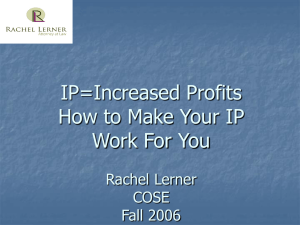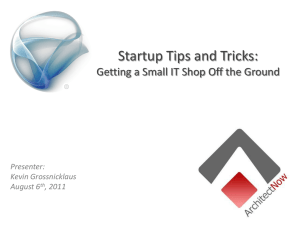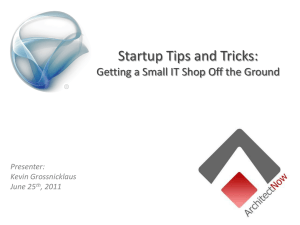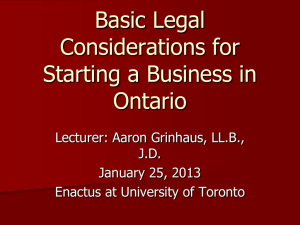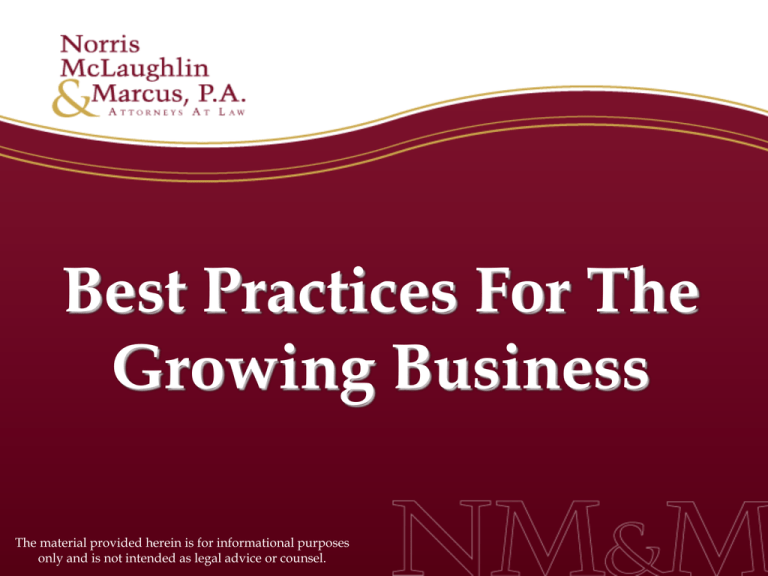
Best Practices For The
Growing Business
The material provided herein is for informational purposes
only and is not intended as legal advice or counsel.
Please help yourself to food
and drinks
Please let us know if the room
temperature is too hot or cold
Bathrooms are located past the
reception desk on the right
Please turn OFF your cell
phones
Please complete and return
surveys at the end of the
seminar
2
Corporate Maintenance, Tune Up
and Succession Planning
Stefanie McNamara
I. Observing Formalities
1.
2.
3.
4.
5.
Governing Bodies
• Shareholders/Members
• Board of Directors/Managers
• Officers
Documenting Corporate Action
• Authorizing Resolutions
• Delegations of Authority for Officers/Key Employees
Meetings
• Annual/Periodic Meetings
Proper Record Keeping
• Minute Book/Stock Ledger
File Annual Report With Department of Treasury
Note:
These Requirements Apply to All Entities Regardless of Size/Number
Failure to Comply Creates Risk of Losing Corporate Shield From
Individual Liability
4
II. Contract Trouble Spots
• Indemnification
• Warranty
• Ownership of IP
• Assignment
• Term and Termination
• Restrictive Covenants
5
III. Corporate Succession Planning
Shareholder (Operating) Agreements
• Restrictions on transfer or issuance of stock/equity
• Buy/Sell Provisions
Voluntary sales to third parties
Upon death/retirement/termination/divorce
Planning your exit strategy
Planning for your partner’s exit
Estate Planning
• Funding – Key Person Life Insurance; Disability
6
Insurance for the Growing
Business - and Beyond
Charles Miller
Risk Management Areas
1.
2.
3.
4.
Liability Loss Exposures
Income Loss Exposures
Property Loss Exposures
People Loss Exposures
8
Liability Loss Exposures
1. Commercial General Liability
Insurance
9
1. Commercial General Liability
Insurance
• Cover bodily injury and property damage
claims
• Excludes coverage for employment practices
claims
• Exclude coverage for professional liability
claims
• Exclude coverage for pollution claims
• How much?
10
Liability Loss Exposures
1. Commercial General Liability
Insurance
2. Commercial Auto Insurance
11
2. Commercial Auto Insurance
• Covers vehicles used by business
• Both property damage and liability
coverage
12
Liability Loss Exposures
1. Commercial General Liability
Insurance
2. Commercial Auto Insurance
3. Professional Liability/Errors and
Omissions Insurance
13
3. Professional Liability/Errors
and Omissions Insurance
• Covers claims arising out providing
professional services
• Covers financial loss
• Excluded from coverage under CGL
policies
14
Liability Loss Exposures
1. Commercial General Liability
Insurance
2. Commercial Auto Insurance
3. Professional Liability/Errors and
Omissions Insurance
4. Employment Practices/Employers
Liability Insurance
15
4. Employment
Practices/Employers Liability
Insurance
• Discrimination
• Wrongful termination
• Sexual harassment
16
Liability Loss Exposures
1. Commercial General Liability Insurance
2. Commercial Auto Insurance
3. Professional Liability/Errors and Omissions
Insurance
4. Employment Practices/Employers Liability
Insurance
5. Business/Profession Specific Liability
Insurance??
17
Income Loss Exposures
1. Business Interruption Insurance
18
1. Business Interruption/Extra
Expense Insurance
• Covers lost cash flow and profits
• Often part of property insurance
coverage
19
Income Loss Exposures
1. Business Interruption Insurance
2. Workers Compensation Insurance
20
2. Workers Compensation Insurance
• Covers job-related injuries
• Mandatory for most employers
21
Income Loss Exposures
1. Business Interruption Insurance
2. Workers Compensation Insurance
3. Disability/Life Insurance
22
3. Disability/Life Insurance
• Disability Insurance
• Life Insurance
23
Property Loss Exposures
1. Business Property Insurance
24
1. Business Property Insurance
• Covers business real and personal
property
• Business auto (property damage)
• Inland marine Insurance
25
People Loss Exposures
1. Workers Compensation Insurance
2. Medical Insurance
3. Business Continuity Insurance
26
3. Business Continuity Insurance
1. Life/Disability Insurance
27
Life Insurance
1. Buy-sell
agreement - set up
by Owners.
2. Life insurance fund the buy-sell.
28
3. Business Continuity Insurance
1. Life/Disability Insurance
2. Key Person Insurance
29
Key Person Insurance
Why?
To compensate the
business for its
losses and to
facilitate business
continuity when
that key person is
lost to the business.
30
Key Person Insurance
Who?
Death or disability would be a financial
detriment to the company
31
“Do I Have Enough Insurance?”
Let’s talk!
32
Questions & Answers Session
Part 1
Seminar Intermission
No Excuses! No Surprises!
Employee Handbooks and
Employment Policies
Pat Collins
Key Practical Issues
• Who is covered
–
–
–
–
Location
Status
Union/Non-Union
Salaried/Hourly
• What is covered
– Are these your policies in practice
36
Key Practical Issues
• Drafting
– Conversational – Non -Threatening
– Avoid Legalese
– Consistency
• Terminology
• Conflicting policies
• Distribution
– Format (hard copy – intranet)
– Time to Review
– Acknowledgement of Receipt
37
Key Legal Issues
• EEO – Discrimination Prohibited
• Anti-Harassment
• Employment At-Will
• Benefits/Payroll Administration
• Privacy Expectations
• Employee Contract
• General Work Rules
38
N.J. Law Against Discrimination (“LAD”)
N.J. Conscientious Employee Protection Act
(“CEPA”)
• Extremely liberal interpretation
– Easier administrative process. No caps on damages.
•
•
•
•
Lower Thresholds than Federal Laws
Allows Suits Against Individuals
Broader Scope of Protected Classes under LAD
CEPA “Reasonable Belief Standard”
39
LAD
• Applies to employers, individuals, and “any
person who aids, abets, or otherwise assists” in
prohibited conduct.
• Makes it unlawful to refuse to buy from, sell to,
license, contract with or provide goods or
services to anyone on the basis of a protected
class.
• Prohibits harassing conduct by third parties
(visitors, customers, vendors).
CEPA
• Applies not only to employees, but independent
contractors as well.
40
EEO – Non-Discrimination –
Anti-Harassment Policies
• Written Policy Mandatory in NJ
– Presumed negligent without one
• Training of Managers Mandatory in NJ
• Risk Losing “Employer Defense”
• Employee Liability
• Good Business Practice
41
Employment At-Will
No Contracts
• Policy emphasized repeatedly
• Introductory Disclaimer
• At-Will Statement
• Benefits Disclaimer
• Codes of Conduct
• Discipline & Termination
• Signed Acknowledgement
42
Benefits/Pay Practices
• Disclaimer – “The Company reserves the right to
amend or terminate any of these programs and to
require or increase premium contributions toward
any benefit programs in its discretion.”
• Benefit Explanations
• Leaves
• Pay Practices
– Safe Harbor Language
• Hours of Work
– Employee Classification
– Overtime Policy
43
Privacy Expectations
• Confidentiality Issues
• Conflicts of Interest
• Company Property/Trade Secrets
• Employee Reference Requests
• Medical Information
• Company Investigations
44
Privacy Expectations
• Drug and Alcohol Testing
• Searches
• Internet and Electronic Media
• Social Media and Networking
– Cell phones, Blackberrys, Smartphones
– Facebook, LinkedIn, Twitter
45
Employee Conduct
• Codes of Conduct
• Performance Reviews
– Counseling
• Discipline
– Avoid progressive
– Require documentation
• Termination
–
–
–
–
Commissions/Bonuses
Benefits paid
Return of property
Exit Interview
46
General Work Rules
•Moonlighting
•Jury Duty
•Emergency Procedures
•Personnel Files
•Tuition Assistance
•Office Supplies/Machines
•Office Hours
•Dress Codes
•Mail/Telephones
•Inclement Weather
•No Smoking
•Media Contacts
•Comp Time
•Weapons
•Inventions
•Direct Deposit
•Violence
•Gifts
•Performance Reviews
•Solicitations
•Customer Relations
•Vacations
•Bulletin Boards
•Arrests/Convictions
•Sick Days
•Radios
•Garnishments
•Holidays
•Layoffs
•Expenses
•Safety
•Resignations
•Language
•Workplace Injuries
•Terminations
•Nepotism
•Family Leave Issues
•Exit Interviews
•Grievance Procedure
•Military Leave
•Office Searches
•Open Door Policy
•Bereavement Leave
•Visitors
•Interns/Trainees
47
Keeping Key Employees
Agreements with Employees and Noncompete Issues – Protection of Company
Assets and Retention of Talent
David Harmon
Retention, Protection and
Enforcement
EMPLOYEES
TRADE SECRETS,
CONFIDENTIAL/
PROPRIETARY
INFORMATION, FILES
AND RECORDS
COMPETITION
COMPANY
CUSTOMERS
COURTS
49
Take Your Employment
Temperature
Ask the following questions regarding your
employees and your business:
Who? What?
When?
Why? How?
50
Ask These Questions While
Considering The Importance Of:
• Protecting company assets and
customer relationships, retaining key
employees, and safely engaging
consultants.
51
Who? What? When?
•
WHO does my company need? From whom does the company need protection and
ongoing loyalty?
Executives, consultants and rank and file employees privy to trade secrets and
confidential/proprietary information, including customer relationships. Protection from
competitors is critical.
•
WHAT can we do to keep key people and protect the company from theft of data,
confidential and proprietary information and interference with employee, consulting
and customer relationships? What happens when the consultant leaves or completes
the engagement?
Create binding contracts that impose reasonable restrictions on activity both during and
after the employment and consulting relationships.
•
WHEN should this be done?
Put agreements into effect at the commencement of employment and/or consulting
arrangements. Or, for employees make them concurrent with reviews and increases in
compensation/benefits.
52
WHY? – Just a Few Reasons:
•
•
•
•
Costs/losses incurred by companies
Increase of theft by employees during recession
Security of company assets and retention of files
Provide protection from competitors poaching
employees and theft of information and relationships
• Put your employees and the competition on notice
and create right to bring claims against departing
employees/consultants for breach of contract and
against your competition for tortious interference
with your contracts
53
How?
• Create agreements
• Provide adequate consideration to
make sure the agreements are
enforceable
• Create employment practices and
policies that dovetail with your
agreements
• Enforce those agreements
54
Agreements With Employees
and Consultants
• Employment Agreements/Consulting
Agreements (key executives, consultants)
• Confidentiality/Non-disclosure Agreements
• Non-Solicitation Agreements (non-poach/raiding)
• Non-Interference Agreements
• Non-Competition Agreements (reasonable in scope,
duration and geography)
• Non-Disparagement Agreements (including “no kiss
and tell” covenants; no ”bad-mouthing”)
• Return of Materials Agreements
• Invention Assignment Agreements (Work for Hire)
55
Retention, Protection and
Enforcement
EMPLOYEES
TRADE SECRETS,
CONFIDENTIAL/
PROPRIETARY
INFORMATION, FILES
AND RECORDS
COMPETITION
COMPANY
CUSTOMERS
COURTS
56
Intellectual Property Essentials
for the Small Business Owner
Kenneth Kaplan
Categories of Intellectual
Property
• Copyrights
• Trademarks and Service Marks
• Patents
• Trade Secrets
58
Copyright Law Basics
• Protects the creative expression of ideas
• Does not protect ideas
• Basic legal requirements:
– Originality
– Fixation
• Protection arises automatically upon fixation
• You get a basket of rights:
–
–
–
–
Make copies
Distribute work
Prepare derivative works
Perform the work
• Lasts for 70 years (for works created after 1977)
59
Registration of Copyrights
• Registration not necessary, but gives
you additional rights:
– Right to sue in federal court
– Ability to recover attorneys’ fees and
statutory damages
• Registration also puts potential
infringers on notice
60
Maintaining Copyrights
• Periodic checks of internet
• Use copyright notice to put potential
infringers on notice and prevent them
from claiming “innocent infringement”
• Proper notice:
–
–
–
–
© or “copyright” or “copyr”
Year of first publication
Name of owner
“all rights reserved”
61
Trademark Law Basics
• Trademarks distinguish your products
and services from those of your
competitors
• Protects your investment in brand
loyalty and good will
• Any word, symbol, slogan, logo or
design may qualify for trademark
protection
62
Acquiring Trademark Protection
• Starts with the choice of a name for your
business
• Continues with the way you brand your
products and services
• Must be used in commerce (“use it or lose
it”)
• Protection arises automatically from use in
commerce (first to use takes precedence)
63
Selecting and Vetting Your
Trademarks
• Using the Internet
• Using a public database like the USPTO
• Professional Search Companies
64
Not All Trademarks are Equal
•
•
•
•
Choose a strong mark instead of a weak one
Arbitrary marks are the strongest
Suggestive marks are the most common
Descriptive marks may put you in a grey
zone
• But, you can protect a descriptive mark by:
– Establishing “secondary meaning”
– Demonstrating exclusive and continuous use for 5 years
• Generic words cannot be protected
65
Benefits of Registration
• Federal and State Registration possible
• Right to use ® symbol
• More damages available
• Mark can become “incontestable” if
used in commerce for 5 years
• You can apply for federal registration
based on an “intent to use”
66
Maintaining Trademarks
• Marking your products and marketing
materials
• Use ® for federally registered marks
• Establish policies and guidelines for use
• Policing your Marks
67
Patent Law Basics
• A monopoly on technology
• Does not arise automatically – must be
filed
• Can take several years to obtain and can
cost several thousand dollars
• Essentially a contract between patent
holder and the government
68
What Can be Patented
• Often said that “Anything under the sun that
is made by man” can be patented
• A “new and useful process, machine,
manufacture, or composition of matter, or
any new and useful improvement thereof”
(Title 35, section 101 of U.S. patent laws)
• Patents in U.S. can be sought for almost any
kind of invention
69
What Cannot be Patented
• Laws of nature (E=mc²)
• Physical phenomena
• Abstract ideas
70
Types of Patents
Two Main Types:
1. Utility Patents:
–
–
–
Most common
Protects a new and useful process, machine, manufacture, or composition of matter, or
any a new and useful improvement thereof
Protects what is useful about your invention
2. Design Patents:
–
–
–
–
No requirement for utility
Protects the appearance of a functional article
Covers only the nonfunctional aspects of a product design (e.g. the design of a car)
Patents protect the ornamental design of an article. Trademarks protect the public
identity of the product.
What about Business Method Patents?
–
–
Historically, “methods of doing business” were not patentable because they did not
fall into any of the four categories of invention: process, machine, manufacture or
composition of matter
71
Up until about 2000 the USPTO took the position that "methods of doing business” are
not patentable
Requirements for Patentability
Invention must be useful, new and non-obvious
• Utility/Usefulness:
–
Usually the easiest of the 3 requirements to establish
• Novelty/Newness:
–
–
–
Invention cannot be patented if (1) it was described in a publication more than
one year prior to the filing date; or (2) was used publicly, or offered for sale to
the public more than one year prior to the filing date.
Inventor who does not file for patent protection on new invention within this
one year grace period will lose all right to obtain patent protection on the
invention.
Most other countries do not grant a grace period. Therefore, it is almost always
preferable to file a patent application before any public disclosure of the
invention.
• Non-obvious
–
–
Invention must be a non-obvious improvement over prior art.
Determination is made by deciding whether the invention sought to be patented
would have been obvious "to one of ordinary skill in the art. In other words, the
72
invention is compared to the prior art and a determination is made whether the
differences in the new invention would have been obvious to a person having
What Rights Does a Patent
Holder Have
• One word: “exclusivity”
• Only a right to exclude others from making,
using or selling your invention
• Unlike a copyright, which only protects actual
copying, patents can protect against
commercial use of an idea and its functional
equivalent
• Right to preclude functionally equivalent
works
• Doctrine of Equivalents is what makes patents
the most comprehensive form of IP protection 73
• Design patents = 14 years
Trade Secret Basics
• Business secrets, unlike published patents and
copyrights which are available for the world to see
• A trade secret is information that:
– Derives value from not being generally known
– Is the subject of efforts to maintain secrecy
• Examples:
–
–
–
–
Formulas
Marketing strategies
Research pertaining to product formulations
Specialized training materials
• Protection can last forever (unlike patents and
copyrights)
74
Trade Secret Protection
• Protected under federal and state laws
• Most states have a version of the
“Uniform Trade Secrets Act”
• Federal Law: the Economic Espionage
Act of 1996: makes it a federal crime to
steal a trade secret or to possess
information that is known to be stolen
75
Advantages over Patent
Protection
• Perpetual protection
• Broader protection that can extend to
business know-how
• Timely and automatic
• No proof of novelty required
76
Safeguarding Valuable Trade
Secrets
• Employee Confidentiality and noncompete agreements
• Customer/Vendor Non-disclosure
Agreements
• Consultant work-for-hire agreements
(making sure you own what you pay
for)
77
Questions & Answers Session
Part 2
Thank you for coming!


